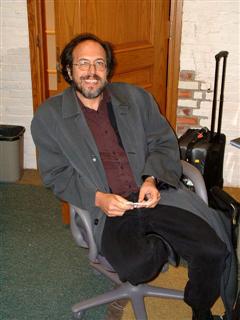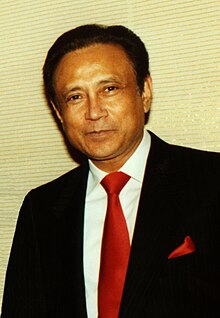
Physical cosmology is a branch of cosmology concerned with the study of cosmological models. A cosmological model, or simply cosmology, provides a description of the largest-scale structures and dynamics of the universe and allows study of fundamental questions about its origin, structure, evolution, and ultimate fate. Cosmology as a science originated with the Copernican principle, which implies that celestial bodies obey identical physical laws to those on Earth, and Newtonian mechanics, which first allowed those physical laws to be understood. Physical cosmology, as it is now understood, began with the development in 1915 of Albert Einstein's general theory of relativity, followed by major observational discoveries in the 1920s: first, Edwin Hubble discovered that the universe contains a huge number of external galaxies beyond the Milky Way; then, work by Vesto Slipher and others showed that the universe is expanding. These advances made it possible to speculate about the origin of the universe, and allowed the establishment of the Big Bang theory, by Georges Lemaître, as the leading cosmological model. A few researchers still advocate a handful of alternative cosmologies; however, most cosmologists agree that the Big Bang theory best explains the observations.

The cosmos is the Universe. Using the word cosmos rather than the word universe implies viewing the universe as a complex and orderly system or entity; the opposite of chaos. The cosmos, and our understanding of the reasons for its existence and significance, are studied in cosmology – a very broad discipline covering any scientific, religious, or philosophical contemplation of the cosmos and its nature, or reasons for existing. Religious and philosophical approaches may include in their concepts of the cosmos various spiritual entities or other matters deemed to exist outside our physical universe.

Lee Smolin is an American theoretical physicist, a faculty member at the Perimeter Institute for Theoretical Physics, an adjunct professor of physics at the University of Waterloo and a member of the graduate faculty of the philosophy department at the University of Toronto. Smolin's 2006 book The Trouble with Physics criticized string theory as a viable scientific theory. He has made contributions to quantum gravity theory, in particular the approach known as loop quantum gravity. He advocates that the two primary approaches to quantum gravity, loop quantum gravity and string theory, can be reconciled as different aspects of the same underlying theory. His research interests also include cosmology, elementary particle theory, the foundations of quantum mechanics, and theoretical biology.

Max Erik Tegmark is a Swedish-American physicist, cosmologist and machine learning researcher. He is a professor at the Massachusetts Institute of Technology and the scientific director of the Foundational Questions Institute. He is also a co-founder of the Future of Life Institute and a supporter of the effective altruism movement, and has received donations from Elon Musk to investigate existential risk from advanced artificial intelligence.

Leonard Susskind is an American physicist, who is a professor of theoretical physics at Stanford University, and founding director of the Stanford Institute for Theoretical Physics. His research interests include string theory, quantum field theory, quantum statistical mechanics and quantum cosmology. He is a member of the US National Academy of Sciences, and the American Academy of Arts and Sciences, an associate member of the faculty of Canada's Perimeter Institute for Theoretical Physics, and a distinguished professor of the Korea Institute for Advanced Study.

John David Barrow was an English cosmologist, theoretical physicist, and mathematician. He served as Gresham Professor of Geometry at Gresham College from 2008 to 2011. Barrow was also a writer of popular science and an amateur playwright.

Neil Geoffrey Turok is a South African physicist. He the director emeritus of the Perimeter Institute for Theoretical Physics since 2019. He specializes in mathematical physics and early-universe physics, including the cosmological constant and a cyclic model for the universe.

The Fabric of the Cosmos: Space, Time, and the Texture of Reality (2004) is the second book on theoretical physics, cosmology, and string theory written by Brian Greene, professor and co-director of Columbia's Institute for Strings, Cosmology, and Astroparticle Physics (ISCAP).
Physics World is the membership magazine of the Institute of Physics, one of the largest physical societies in the world. It is an international monthly magazine covering all areas of physics, pure and applied, and is aimed at physicists in research, industry, physics outreach, and education worldwide.

Alexander Vilenkin is the Leonard Jane Holmes Bernstein Professor of Evolutionary Science and Director of the Institute of Cosmology at Tufts University. A theoretical physicist who has been working in the field of cosmology for 25 years, Vilenkin has written over 260 publications.

Michał Kazimierz Heller is a Polish professor of philosophy at the Pontifical University of John Paul II in Kraków, Poland, and an adjunct member of the Vatican Observatory staff. He also serves as a lecturer in the philosophy of science and logic at the Theological Institute in Tarnów. A Roman Catholic priest belonging to the diocese of Tarnów, Heller was ordained in 1959. In 2008 he received the Templeton Prize for his works in the field of philosophy.

Sean Michael Carroll is a theoretical physicist specializing in quantum mechanics, gravity, and cosmology. He is a research professor in the Walter Burke Institute for Theoretical Physics in the California Institute of Technology Department of Physics and an External Professor at the Santa Fe Institute. He has been a contributor to the physics blog Cosmic Variance, and has published in scientific journals such as Nature as well as other publications, including The New York Times, Sky & Telescope, and New Scientist.

Thanu Padmanabhan is an Indian theoretical physicist and cosmologist whose research spans a wide variety of topics in Gravitation, Structure formation in the universe and Quantum Gravity. He has published nearly 300 papers and reviews in international journals and ten books in these areas. He has made several contributions related to the analysis and modelling of dark energy in the universe and the interpretation of gravity as an emergent phenomenon. He is currently a Distinguished Professor at the Inter-University Centre for Astronomy and Astrophysics, (IUCAA) at Pune, India.
Walter Thirring was an Austrian physicist after whom the Thirring model in quantum field theory is named. He was the son of the physicist Hans Thirring.

Victor John Stenger was an American particle physicist, philosopher, author, and religious skeptic.

The Whole Shebang: A State-of-the-universe(s) Report is a 1997 science book by author Timothy Ferris. In his book he provides a wide-range report of current research on cosmology, the study of the universe, and its trends going into the 21st century. He reports on theories about the possibility that our universe is one among many, the Big Bang theory, Black holes, the "expanding" universe, and "curved" space. The book has twelve chapters with most of it exploring the Big Bang theory and the mass density of the universe.
Cosmic Quantum Ray was a German-French animated CGI animated television series. The series premiered in the U.S. in November 5, 2007 on Animania HD, then in 2009 in Germany on KiKa and then later on October 10, 2010, on The Hub. It also aired on Science Channel as part of a sneak peek of the latter. As of 2019, the series is now being broadcast on Qubo. It was produced by Moonscoop, Mike Young Productions, Method Films, and Telegael Torenta.

A Universe from Nothing: Why There Is Something Rather than Nothing is a non-fiction book by the physicist Lawrence M. Krauss, initially published on January 10, 2012 by Free Press. It discusses modern cosmogony and its implications for the debate about the existence of God. The main theme of the book is how "we have discovered that all signs suggest a universe that could and plausibly did arise from a deeper nothing—involving the absence of space itself and—which may one day return to nothing via processes that may not only be comprehensible but also processes that do not require any external control or direction."
The index of physics articles is split into multiple pages due to its size.
Ramanath Cowsik is an Indian astrophysicist and the James S. McDonnell Professor of Space Sciences at Washington University in St. Louis. He is considered by many as the father of astroparticle physics. A recipient of the Shanti Swarup Bhatnagar Prize, Cowsik was honored by the Government of India, in 2002, with the fourth highest Indian civilian award of Padma Shri














